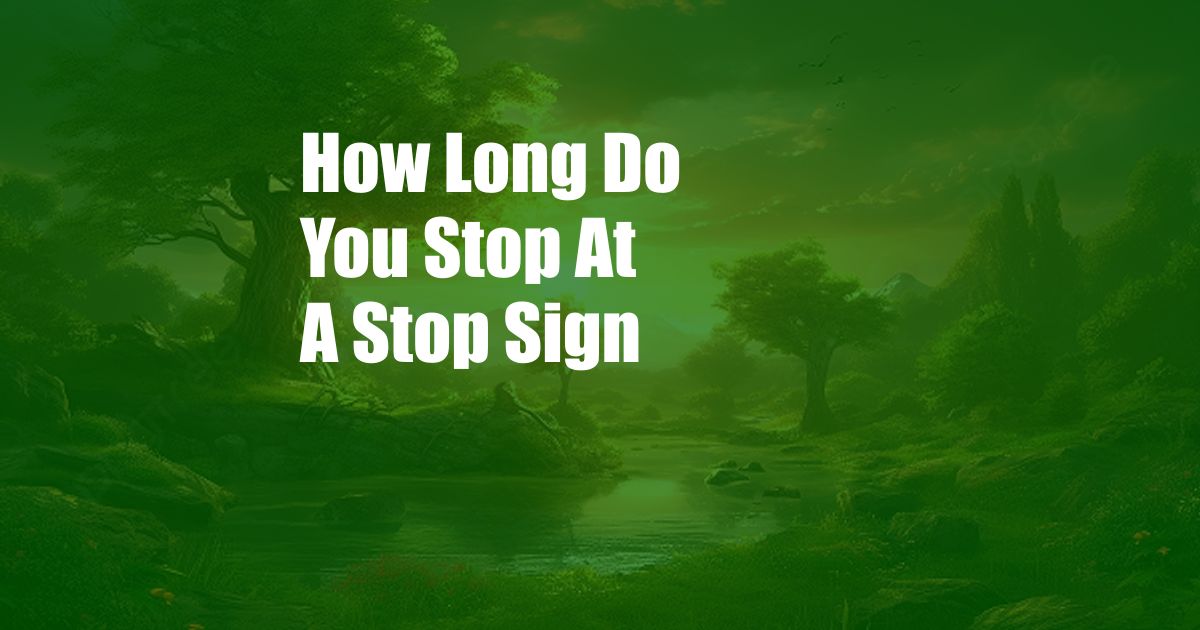
How Long Should You Stop at a Stop Sign?
As a child, I remember being taught the importance of coming to a complete stop at stop signs. I recall slowing my bike to a crawl and placing my foot down firmly on the ground, ensuring my bike came to a complete stop before proceeding. The fear of being reprimanded by neighborhood adults or getting into trouble with my parents if I didn’t stop properly was deeply ingrained in me. Growing up, I realized that this practice is not always followed by everyone, especially in the hustle and bustle of city life. Many drivers roll through stop signs, barely slowing down, while others treat them as yield signs, proceeding only when the way is clear. This raises the question: how long is long enough when it comes to stopping at a stop sign?
According to the National Highway Traffic Safety Administration (NHTSA), drivers are required to come to a complete stop at stop signs. This means your vehicle must come to a full and complete stop before proceeding. Failure to do so can result in a traffic citation or, more importantly, an accident. The amount of time you need to stop will vary depending on the speed you’re traveling and the road conditions but generally speaking, aim for at least 3 seconds.
The Importance of a Complete Stop
Coming to a complete stop at stop signs is crucial for several reasons. First, it gives you time to assess the situation and make sure it is safe to proceed. This is especially important at intersections where there is limited visibility or heavy traffic. A complete stop allows you to check for pedestrians, cyclists, and other vehicles before moving forward.
Second, a complete stop helps to reduce the risk of accidents. When you come to a stop, you are giving other drivers and pedestrians a chance to react to your presence. This can help to prevent rear-end collisions, side-impact collisions, and other types of accidents. By taking a few extra seconds to stop completely, you can significantly reduce your chances of being involved in an accident.
Common Mistakes When Stopping at Stop Signs
While it may seem like a simple task, there are several common mistakes that drivers make when stopping at stop signs. Some of the most common mistakes include:
- Rolling through the stop sign without coming to a complete stop
- Stopping too far away from the stop line
- Stopping too close to the stop line
- Not yielding to pedestrians or other vehicles
- Not signaling when turning
By avoiding these common mistakes, you can help to ensure your safety and the safety of others on the road.
Tips for Stopping at Stop Signs
If you want to be a safe and responsible driver, it’s important to know how to stop properly at stop signs. Here are a few tips to help you:
- Slow down as you approach the stop sign.
- Come to a complete stop at the stop line.
- Hold your foot on the brake until you’re ready to proceed.
- Look around carefully to make sure it’s safe to proceed.
- Signal before turning.
- Yield to pedestrians and other vehicles.
By following these tips, you can help to keep yourself and others safe on the road.
FAQs About Stop Signs
Here are some of the most frequently asked questions about stop signs:
- What is the legal definition of a complete stop?
- How long should I stop at a stop sign?
- What should I do if I’m behind a car that doesn’t stop completely?
- What are the penalties for not stopping at a stop sign?
A complete stop is defined as coming to a full and complete stop before proceeding. Your vehicle must be stationary for at least 3 seconds.
Generally speaking, you should stop for at least 3 seconds. However, the amount of time you need to stop will vary depending on your speed and the road conditions.
If you’re behind a car that doesn’t stop completely, be prepared to stop yourself. Don’t assume that the other driver will stop. It’s always better to be safe than sorry.
The penalties for not stopping at a stop sign vary from state to state. However, you can typically expect to receive a traffic citation that includes a fine and points on your driving record.
By understanding the importance of stopping completely at stop signs and following the tips and advice provided in this article, you can help to keep yourself and others safe on the road. So next time you approach a stop sign, take a few extra seconds to come to a complete stop. It could save your life or the life of someone else.
Are interested in learning more about traffic safety? Visit the NHTSA website for more information.